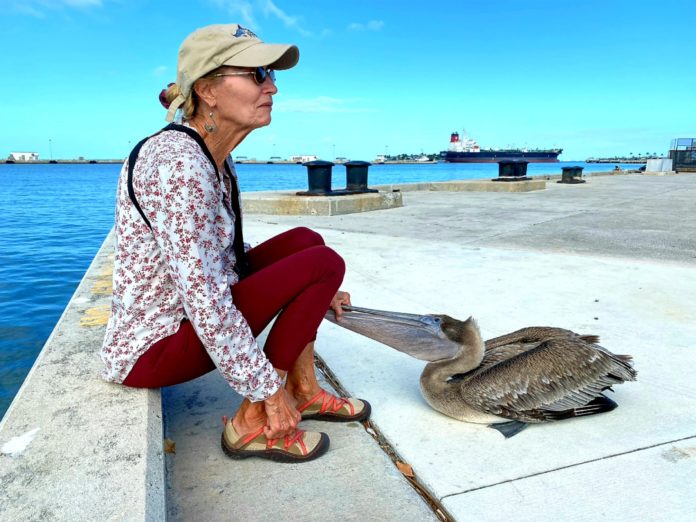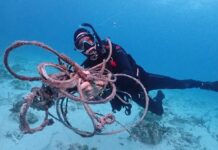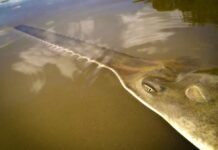
Ellen Westbrook and I were riding our bikes around the edge of Old Town, along the water, counting every damn bird we saw – every mockingbird, every gull, every dove. Because it was the 122nd annual Christmas Bird Count and you don’t mess with tradition.
This was the second year we’d done the CBC by bike, but it surely made sense, what with COVID and traffic and parking. Also, it was just easier to see and hear things while we were moving. Also, it was fun.
At the boat ramp at Truman Waterfront I scanned the pilings and piers, hoping to catch sight of some black skimmers. Ellen started eyeing a particular brown pelican.
Ellen does a lot for the Florida Keys Audubon Society, but she also does a lot for the Key West Wildlife Center, the folks who help sick and injured birds any way they can. She knows a pelican that isn’t quite right when she sees it.
The bird sat on the edge of the gray seawall. Ellen leaned her bike on its kickstand, and walked up to it. It did not fly away, which was a sign. It did turn and snap at her, which she knew was coming and easily dodged. Pelicans have sharp hooks on the ends of their bills. If you don’t know what you are doing you could get hurt, or worse, you could hurt the bird. But Ellen has grabbed pelicans a few thousand times.
She reached for the bird, it snapped again, she deftly dodged again. The snapping sounded like a large pair of chopsticks clacking. After several cycles, she gently wrapped hand around the bird’s bill and held it. It was like the kids’ game of Got Your Nose, only it worked. The pelican flapped some, but couldn’t go anywhere.
I called Tom Sweets from Key West Wildlife Center, who said he’d be there as soon as possible. So I sat down next to Ellen and the pelican and she told me about working with them at the clinic.
“The ones that come in like this – it’s their first migration. He is a pristine bird. There’s no cuts or scabs on his feet. His feathers are all perfect. They get this far and they just don’t have the energy to fish,” she said. “I could tell from over there that he wasn’t right. The way his head was. The way he was resting.”
“I don’t think he has a big parasite load. Otherwise I’d be covered with them by now. They don’t live on people. I mean, in 10 or 12 hours, they’re all dead,” she said. Then she looked at the bird.
“We’re just gonna sit here quietly and wait for somebody to come pick you up. You’re a beautiful bird. The very fact that I can just reach down and get you means that you are not working right,” she said.
“This is a boy. The male beaks are about two inches longer than the female. And he looks newly hatched. Every feather is just perfect. He’s not all scarred up like an adult would be. Remember “The Velveteen Rabbit”? He’s not all torn up yet. The pieces aren’t falling off. His webbing is just uncut and perfect. You don’t see that in an adult.
“We feed them and offer them fish in the clinic. Once they start eating well and getting a little more active, we take them out to the aviary, to the pool room with other pelicans their same age. We put all the juveniles together. And then they eat communally. They get to this room where they can fly. Tom watches over them. And when they’re all flying really well, he’ll take four to six of ’em at once and release them as a group. He might be with us a month. I don’t know.
“The pelicans we get here, some of them are banded, and all the bands are from South Carolina. So we think that this group that we get here in the winter summers in South Carolina,” she said.
“We get calls all the time from people saying they see a pelican and he’s got monofilament trailing from around his feet or around his wing. As long as they can fly and get away from us we’ll never catch him. Tom will come down and try to bait them in. But until it interferes with their ability to feed themselves we can’t get them. Once we get them, we can get the hooks out and staple up whatever tears they have. We got one last week that had monofilament wrapped tightly around the wing, to the point where it was interfering with circulation. We were worried it would lose the wing, but Peggy (Koontz) massages it several times a day and it seems to be coming back. It seems to be moving a little more normally. So we think he’s gonna survive this,” she said.
While we were sitting there, a police car passed and didn’t give a second glance at the woman holding the pelican by the bill. Ellen told me she’d come across another sick pelican a few weeks prior while walking the dog. She’d carried it a mile back to the car, and of all the people she passed, none of them said a word to the woman holding the four-foot-tall bird.
“When they’re weak they don’t struggle. A normal bird would not let this happen. We can tell they’re getting better when you pull them out of their crates to tube-feed them and they fight on the way out of the crate, they fight the feeding tube, they fight going back into the crate. And you’re like, ‘Good! You’re feeling like a normal bird. That’s what you should be doing.’ This guy? Look at him. He’s too weak, too weak to fish,” she said.
We could see Tom pulling up in his pickup. Ellen gathered the pelican and held it like a plush toy she’d won at the carnival. After Tom loaded him in a crate to take back to the clinic we added it to the list, got on our bikes, and went off to count more birds.


























